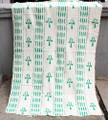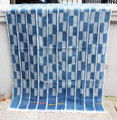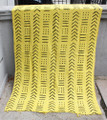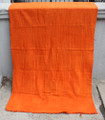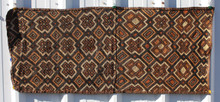 Loading... Please wait...
Loading... Please wait...- Home
- African Textiles & Scarves
- Kuba Cloth
- Kuba Boutella 361 A
Product Description
The art of the Kuba of Zaire, which ranges from pipes to cups, metal to weapons, basketry to furniture to textiles, is remarkable for its abstract patterning. Traditional appliqued cloth was primarily made into dance skirts. Skirts and embroidered Kuba textiles were produced and used for ceremonial occasions and court rituals. Until it was replaced by cowry shells, the basic Kuba weaving unit, an undecorated square of plain cloth, the mbal, was used as currency. Kuba cloth is woven from raffia palm leaves. Production of the fine decorative textile is a series of endeavors engaging both men and women. The men are responsible for the growing, tending, harvesting and weaving of the cloth. The women are responsible for preparing it for decoration by pounding the stiff, rough cloth in a large wooden mortar until softened, for hemming and in some cases, treatment with brown, wine-red, black blue or yellow dye from local plant sources. The women create the cut pile embroidered panels as well. The men's dancing skirts are significantly longer than that of the womens, sometimes having distinct borders with fringe and raffia bobbles. The womens skirts up to nine yards in length, would be wound around the body several times and folded over a belt. Some of the decorative techniques incorporated by both men and women are applique and reverse applique, dyeing, tie-dyeing and resisted-dyeing, certain types of embroidery as well as patchwork. Patchwork in Kuba cloth came about because of the softening process. The pounding would cause holes to develop in the cloth that would need to be repaired; thus patchwork would be used. To further enhance the look and to balance the visual effect, other patches of various geometric designs were added. Some dancing skirts can take up to two years before all the cloth needed to finish the skirt has been gathered. The Kubas primary contemporary use of the cloth is at funerals of wealthy elders. The traditional techniques used to create the cloth have survived because of these funerals, enabling us to continue to enjoy the extraordinary creative Kuba textiles. A sub category of Kuba textile art is the Kasai or "velvet" cut-pile cloths which are created by a combination of embroidery and a cut pile technique. These celebrated cloth sections are intensely decorated with intricate original geometric designs. Some patterns are stitched directly onto the cloth. For background, the artist will pull several strands through the base cloth with a needle, and then cut them, creating a tight natural "velvet" pile with a knife. The fibers are not tied, but held in place by the tightness of the weave of the base cloth, the mbal. The Kasai velvet was sewn together for ceremonial dress and has appeared as a covering for important royal stools. This type of cloth was also used as currency and often was an indicator of a familys' wealth and tribal status. Cut pile cloths are not fragile and can serve versatile decorating additions.
The more contemporary versions have forsaken the "velvety tuffs" for more elaborate designs such as in the case of this selection.
This is a beautiful work of textile craftsmanship that shows off various tribal patterns done in natural, brown, rusty orange and black!
Folds or wrinkles can be removed with misting and ironing from the back.
Please click photo for enlargement!
Sold
Dimensions: 50 inches across x 21 inches long
Any QUESTIONS please leave a message her at Contact Us!
*Free or fixed shipping for domestic orders only*



